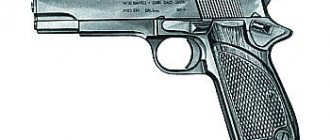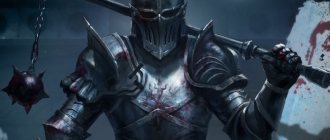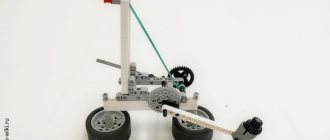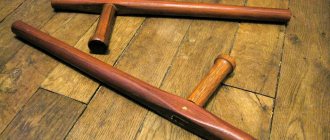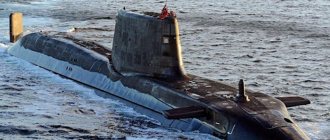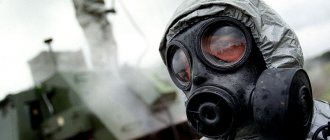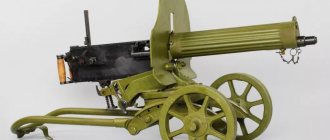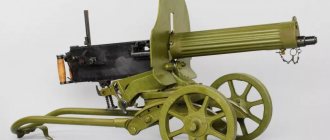The Yawara, despite its harmless appearance, is a fairly effective self-defense weapon. Unlike the kubotan (which was developed relatively recently), the yawara is an ancient Japanese version of the brass knuckles.
Yawara is a small stick made of wood or other hard material that is held in the fist. In this case, the ends of the stick should protrude beyond the fist on both sides by 3-5 centimeters. Similar weapons were used not only in Japan, but also in Russia (chizhik), Vietnam (kobo), Malaysia (dulo-dulo). Often the ends of the yawara are sharpened on both sides in the form of a cone, which allows you to strike, all the energy of which will be concentrated at one point. Some models of the yawara are equipped with a transverse spike, which allows the yawara to be used for attacks. However, you should not look for or make such a model for yourself; it can easily be recognized as a knuckle-type melee weapon.
Instead of a javara, you can use any improvised object that is similar in shape, the fighting technique will not change. Perfect for:
- Nails;
- Spanners;
- Metal combs and similar items.
The popular tactical pen is also used in a similar way to the Yavara.
How did Yavara appear?
There are two official versions of the origin of Yavara:
- According to the first version, yawara is a vajra modified by the Japanese for self-defense, which is a symbol of lightning, one of the shrines of Buddhist monks. Seeing how cleverly the monks use the vajra, the Japanese refined it to perfection;
- If you believe the second version, then yavara is nothing more than an ordinary pestle that peasants used on the farm to crush grain.
Considering that self-defense in those days was of interest only to unarmed peasants, they most likely simply began to use pestles by analogy with the vajra.
The traditional yavara was made of hard wood; those trees were especially loved, which were considered to be the repository of spirits. A yawara stick made from such a tree was supposed to convey to its owner the strength and wisdom of forest spirits. Due to its general availability, yavara was extremely popular among the peasant class. Using the yawara as a weapon of self-defense, it was possible to resist several unarmed opponents.
In the martial arts of medieval Japan, yawara was often used to perform the clenching of the “correct” fist. There is an opinion that an analogue of javara was also used in Europe, but this is fundamentally incorrect. Given the availability of a huge number of different weapons, there was simply no need for weapons such as the yawara. For spies and secret assassins, various types of knives and stilettos were much more effective. Do not think that the variety of traditional Okinawan weapons arose because blade weapons were ineffective. It’s just that it was banned, so we had to come up with various alternative options.
Distribution in medieval Europe
In the 17th century, there was a real boom in outlandish weapons among the European aristocracy. The atmosphere of intrigue, secret conspiracies and secret societies contributed a lot to this. Rings with hidden spikes, twisting blades, and any other seemingly safe item that could be used as a weapon were all in great demand. On this wave, Japanese yawara also gained popularity. But the fashion for this weapon was short-lived. Yavara has not become as widespread as in its native East anywhere in the world.
Why do you need Yavara and how to choose your option
The main key in self-defense with Yavara can be called impact on the enemy’s pain points. Don’t think that these are some secret and hard-to-reach places on the human body. It is enough to deliver a series of blows to the neck, joints or head. It is best if the yavars are in both hands. The technique of fighting with Yawara is not difficult to learn, because it is based on instinctive punches (the traditional punch with the knuckles is not instinctive).
Each yavara is unique. Of course, there are factory models, but they do not take into account the characteristics of a particular person. After all, everyone’s hand is different, and accordingly, the yavara should be different. It’s better to make your own self-defense weapon or upgrade a purchased one. Often on sale you can find yavars decorated with elaborate carvings. You should not spend money on such a product, the yawara should be simple and convenient; it will not withstand more than a few serious fights: it will either break or get lost (some equip the yawara with a rope that prevents the weapon from falling out of the palm).
Various origin theories
The Yawara is a weapon with a controversial history. Experts do not know exactly who and when came up with the idea of using a short stick with pointed ends held in the palm to strike the enemy. Most likely, this happened by accident; in a moment of danger, the person simply grabbed what came to hand. There are several versions, they all seem more or less plausible, but the truth is probably hidden somewhere in the middle.
Some researchers suggest that the prototype of the yavara is the vajra, a Buddhist symbol of faith. These objects are similar in shape (we see the vajra in the next photo in the hand of the deity).
This theory is also supported by the fact that clergy were prohibited from having weapons. But the vajra was not considered a weapon. Perhaps the idea of a non-standard use of a religious attribute occurred to some desperate monk.
The second theory is more prosaic, but many seem more plausible. According to her, the forerunner of yavara was an ordinary pestle for grinding spices in a mortar. There was a similar thing in every home.
Javara fighting technique
To use javara most effectively, you need to have a sharp and quickly delivered blow. The ends of the yawara are capable of delivering powerful traumatic blows. Even if a person does not know how to punch correctly, a yavara can be punched with all its might without fear of a dislocated wrist or a broken fist. Of course, before using yawara in battle, it is better to practice with a partner or at least on a dummy. Don't think that Yawara will turn you into a super fighter. It can only increase the force of impact, it will not add speed and reaction speed to you.
Some martial artists recommend using yawara for the left hand so that the right hand can be used for traditional combat. This point of view is appropriate when the battle is fought by a trained hand-to-hand fighter, all of his technique is designed specifically for punches (yawara can become a hindrance for him). It is better for an ordinary person to hold the yawara in his right hand and study the strikes with it, since they are faster (in the case of a right-hander).
What is Kubotan?
Some believe that kubotan is a type of yawara. Actually this is not true.
Yawara and Kubotan are similar weapons in appearance, and they are used for almost the same purpose. But we must distinguish between them.
Kubotan was developed by the 10th dan grand master of martial arts Kubota Takayuki not so long ago - in the 70s of the last century. The master created a non-lethal weapon commissioned by the Los Angeles Police Department. The Kubotan is a weighted keychain that has only one pointed end. It does not enhance the power of the strike as much as it protects the striker's hand. The weapon has proven combat effectiveness, and therefore is still in service with many patrol units.
However, looking at the kubotan, it is easy to understand that the development is based on ancient jawara.
Yawara grip methods
There are five main ways to hold a yawara, although there are various combination grips.
- A grip in which the ends of the yawara protrude from the fist at the same distance;
- When the end protrudes only from below;
- When the end protrudes from above;
- Regular “knife” grip;
- “Finnish” knife grip, when one end rests on the palm.
There is no need to use different grips, just try to find the most optimal option for you and practice it. It is advisable to train with a partner and at full strength. In this case, use a piece of rubber hose of similar dimensions, otherwise serious injuries cannot be avoided.
The technique of using javara is perfectly combined with punches and kicks. Use the full potential of strikes with dodges and movements - this will give you a serious advantage in any fight.
Most effective strikes
To practice your strikes, it is advisable to take time and practice with a partner. We will consider not only classic, but also strikes prohibited in sports, based on the impact on a person’s painful points. There are many such points on the body:
The blows described below hit the most vulnerable places on the attacker's body:
Direct hit. Apply to the nose, jaw, eyes, neck, throat. Capable of “knocking out” an attacker, knocking him out and knocking him down. Advice for beginners: to avoid injury to the hand and knuckles, you should hit not with your fist, but with the heel of your palm:
Uppercut. It is struck with a fist into the opponent's jaw from bottom to top. Instantly neutralizes the attacker. When delivering a blow, it is recommended to turn your fist slightly towards you - this way the blow will be stronger (to practice the blow you need training, because unprepared knuckles and fingers can be knocked out):
Kick to the groin. A mean but reliable blow that can seriously harm the offender. You can hit with your knee or foot, or with your hand backhand. To be more effective when hitting your opponent with your knee, you can grab them by the chest and pull them towards you. It is better to hit with your foot when it is impossible to reach with your knee:
A blow to the kneecap. A painful and effective blow. Apply from the side or straight. If you hit from the side, you can throw the enemy off balance, and if you hit him directly, you can break his bone or joint:
Hit the sun. Apply to the solar plexus area. You can hit with your fist or the heel of your palm, but as sharply as possible. When attacking from behind, it is convenient to hit with your elbow. The blow knocks out the breath and neutralizes the offender (a strong blow makes him unconscious):
Kick to the shin. Causes severe sharp pain in the opponent, as well as temporary paralysis of a limb or bone fracture. It is recommended to hit with the inside of the sole. You can hit with a toe only if you are wearing durable shoes with a hard toe or a massive tread:
Palm slap to the ears. Belongs to the category of prohibited. Quickly throws an opponent off balance, stunning him. May damage eardrums and cause ear bleeding:
Hitting the toes or the instep of the foot. It is better to apply with the entire heel. Can cause temporary limb paralysis and broken fingers:
Zhua
This name sounds like a drunken person trying to utter an obscene word, but its bearer is a terrible weapon whose appearance causes something to shrink to the size of a needle's eye. At that moment, when this crap rushes towards the body, the unfortunate person thinks only about one thing: why is it not a sword, why is it a stick with claws, like a bear’s leg? This is exactly what it looks like - like a hand or paw with large claws screwed to the shaft. And the word is translated according to its appearance: “zhua” - “tear with claws.”
Many people disliked the masters of this weapon in Ancient China, because its main purpose was not to kill, but to torment enemies, torment them, forcing them to languish in painful agony. The equipment coped with its task perfectly, perfectly tearing out pieces of flesh, crushing bones and demoralizing the enemy. And thanks to the long handle of this weapon, even mounted warriors were afraid.
Mask fragments
The Land of the Rising Sun took a direct and obvious course towards reviving military power in 2012, when Prime Minister Shinzo Abe came to power for the second time.
Six years later, in the thirtieth year of the Heisei era, Minister Abe hosted a large parade of the Self-Defense Forces at a military base in Saitama Prefecture. In ceremonial court attire, tailcoat and top hat, he spoke these words to the still-not-quite-military soldiers:
The time has come for you to fulfill your responsibilities as a political force. To create an environment in which all Self-Defense Forces can perform their duties with a sense of pride.”
Well, the military as a political force is a venerable Japanese tradition. The same as geisha in a kimono with a lowered collar and admiring sakura while hugging a bottle of sake. Warlords-shoguns ruled the country for several centuries. A serious factor in the political life of Japan in the pre-war era was the fascinating confrontation between the army and navy.
Then, impeccable ceremonial boxes passed in front of the stands, accompanied by those same marches covered in glory. Including in full combat gear. We passed the latest Type 10 MBTs and even newer Type 16 wheeled light tanks. The F-35s rushed by.
Shinzo Abe at a military parade in Asaka, 2016
Yes, this parade was much inferior in colorfulness and pathos to the Chinese or Russian ones. But in every gesture, every look, every wave of the flag, it was too clearly read for a pacifist democracy: Gentlemen, we love war. Gentlemen, we love war very much!”
Prime Minister Abe has set the deadline for revising the anti-war Article 9 of the constitution to 2022. Most likely, this will happen, despite the opposition. The self-defense forces will be directly called armed. The army will become an army, the navy will become a navy. This will be both a statement of what has already happened and the beginning of a new era.
The Japanese military, formally becoming "military", will inevitably strengthen its already considerable political weight, despite the protests of pacifists and the opposition of the parliamentary opposition.
And there are cultural shifts happening. Even twenty years ago, it would have been difficult to imagine a popular anime series where the Self-Defense Forces cheerfully invaded - yes, in self-defense! - into a foreign world. And they are not engaged in peace-making, chewing gum and jeans, but with open pleasure they are inflicting democracy and inflicting freedom with missile and bomb strikes, tanks, attack helicopters, multiple launch rocket systems and special forces raids.
Haven’t you seen how a pair of Phantoms with the support of MLRS and Apaches with Hellfires cope with dragons? Look, it's entertaining.
And the scenes of targeting the Ordnung through the methodical shooting of powerless crowds of enemies with swords and bows from machine guns with the support of turntables look slightly ethically dubious even to my cynical opinion.
The implications of all this could be interesting.
However, dear reader, you are already tired of the lyrics. You want numbers. I have them.
Features of self-defense on the street
The street is not a gym, and compliance with sports and moral rules is not provided here. Almost always any street fight is a fight without rules. Also on the street there is a factor of surprise: a criminal can attack at any time and from anywhere. The stake here is on fear and shock, in which it is difficult to take any adequate action. When walking or going somewhere, you should always keep in mind that an unforeseen extreme situation may arise in which you will have to defend yourself. Of course, there is no need to be paranoid, but you should always and everywhere critically evaluate the situation. The advantage is that when attacked on the street, the defender has many options: from running away to using a wide variety of techniques.
Legality
According to Article 6 of the Federal Law “On Weapons”, on the territory of the Russian Federation it is prohibited to trade in: “flails, brass knuckles, shurikens, boomerangs and other objects of impact, crushing and throwing action specially adapted for use as weapons, with the exception of sports equipment.” Kubotan is officially a keychain and is not automatically subject to this ban. Unlike some of the items above.
In many other countries of the world, the same principles apply in matters of impact weapons as in the Russian Federation. Therefore, when traveling abroad with such a key fob, you should not have any problems there either.
Description
The classic kubotan is a cylindrical rod made of hard plastic, wood or metal. Its dimensions are approximately 14 cm in length and 1.5 in diameter. This device weighs 60 grams or so. For ease of grip and use, six transverse stripes are usually cut on its surface. A hole with a ring at one of the ends is required.
Despite its small size and harmless appearance, the kubotan is a fairly powerful self-defense weapon, with which you can even cope with an enemy that is larger and stronger than you.
